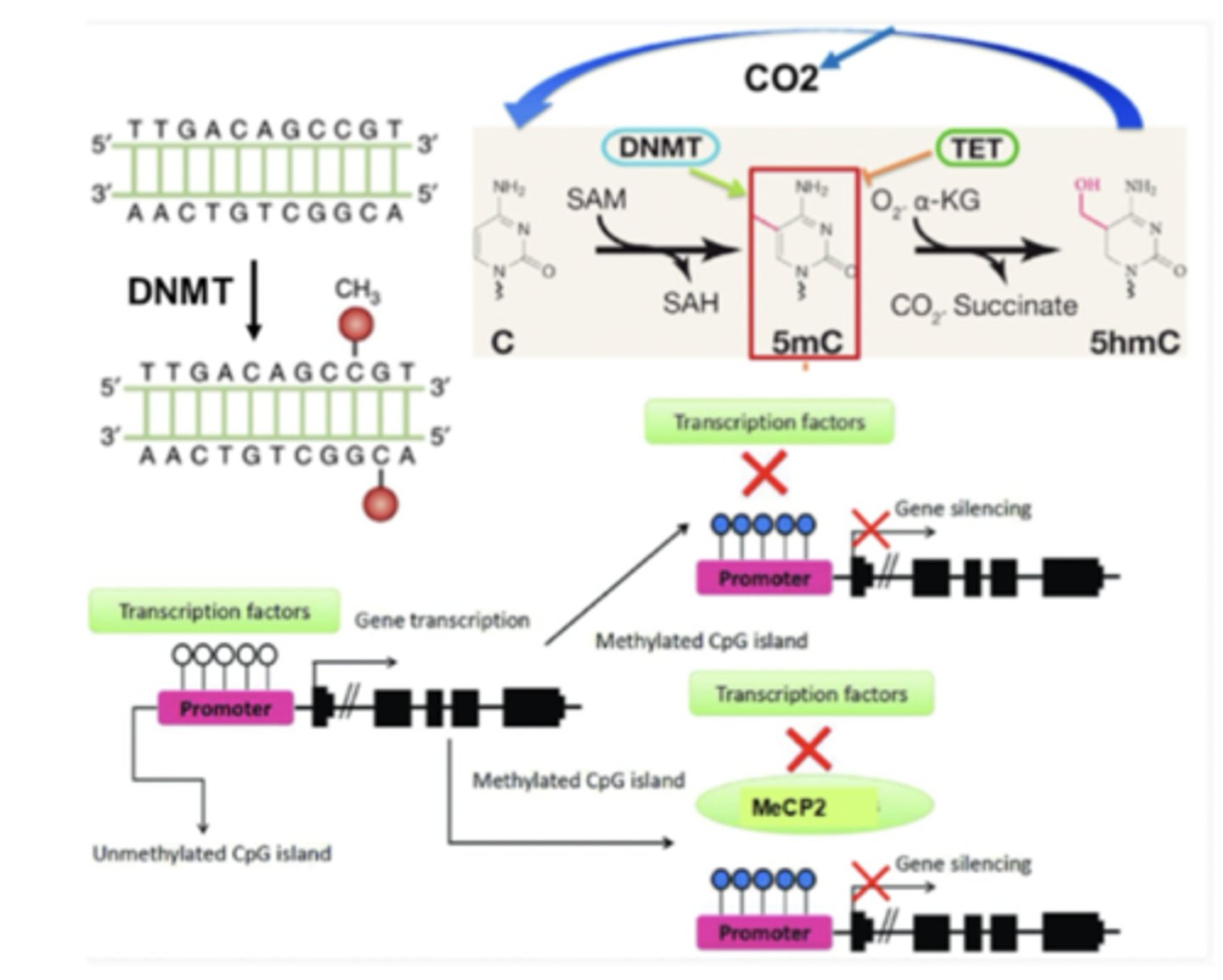DNA Structure
1/22
There's no tags or description
Looks like no tags are added yet.
Name | Mastery | Learn | Test | Matching | Spaced |
|---|
No study sessions yet.
23 Terms
What are chromosomes?
They are threadlike structures made of protein and a single molecule of DNA that serve to carry the genomic information from cell to cell.
Each pair has two, one from each parent
After replication, two sister chromatids that are copies of each other joined at centromere (constricted region of chromosome and plays a key role in helping the cell divide up its DNA during division).
What is heterochromatin?
Regions of chromatin containing transcriptionally inactive genes that are tightly packed and less accessible for transcription.
What is euchromatin?
Genes that are either active or potentially active located in a lightly packed form of chromatin
What are the structure and function of centromeres?
Centromere is the constricted region of chromosome and plays a key role in helping the cell divide up its DNA during division.
It is the region where the cells spindle fibers attach (microtubules) - after attachment of spindle to centromere, two identical sister chromatids pulled to opposite sides and result in two daughter cells.
What are the structure and function of telomeres?
Telomeres are regions of repetitive DNA sequences at the end of a chromosome - this is how cells protect chromosome ends - it is a long stretch of short DNA sequence repeated 100s of times. At the end is the T-loop that keeps chromosome ends from being ligated together. When cell divdes, telomere repeats get cut off, so telomerase adds repeats back so it dont get too short.
What is the structure of chromatin?
Negatively charged DNA loops twice around positively charged histone octamer to form nucleosome bead.
H1 ties nucleosome beads together in a string
What are the properties of histone proteins?
They are positively charged (high in arg and lys), form nucleosomes, and subject to post-translation modifications.
Describe the role of histone acetylation and deacetylation in regulation of chromatin structure, and histone modification in general
Covalent modification of histones create binding or docking sites for chromatin remodeling complex that increase accessibility of adjacent DNA sequences to enable transcription or conversely to compact chromatin structure to prevent gene expression.]
![<p>Covalent modification of histones create binding or docking sites for chromatin remodeling complex that increase accessibility of adjacent DNA sequences to enable transcription or conversely to compact chromatin structure to prevent gene expression.]</p>](https://knowt-user-attachments.s3.amazonaws.com/6acf03c3-826f-4d1a-af6c-87c2493ffe2f.jpg)
What is Sumoylation?
A post-translational modification in whcih a SUMO (small ubiquitin-like modifier) is covalently attached to target protein. They regulation protein function without tagging it for degradation. Enzymes involved include E1 (activating), E2 (conjugating), and E3 (ligating). This is reversible via SENP (SUMO-specific proteases).
SUMOylation is involved in nuclear transport, DNA repair, stress responses, transcriptional regulation, and synaptic plasticity.
What is ubiquitination?
Post-translational modification in which a small protein (ubiquitin) is covalently attached to a target protein. This marks the protein for degradation by proteasomes, but can also regulate other processes (cell signaling, trafficking, and DNA repair). Multiple ubiquitins are usually for degradation. Monoubiquitination are usually for signaling and other things.
What is acetylation?
Post-translational modification in which an acetyl group is covalently attached to a molecule, most commonly to omega-amino group of lysine residues in proteins. This alters function, localization, stability, and interactions.
What are HAT enzymes?
Histone acetyltransferases add acetyl groups to lysine residues
What are HDAC enzymes?
Histone deacetylases remove acetyl groups, reversing acetylation
What is methylation?
Post-transcriptional/epigenetic modification where methyl group is added to molecule. This affects gene expression, protein function, and cellular identity.
What are the two types of methylation?
DNA methylation to the 5'carbon of cytosine in CpG dinucleotides. This is done by DNA methyltranferases and it silences gne expression. This is stable and heritable (key to cell differentiation and imprinting).
Protein methylation (lysine and arginine residues) are common in histones and TFs. The enzyme is histone methyltransferases reversed by demethylases. This activates or represses gene expression depending on site of methylation (H3K4 vs K3K9), and if its mono, di, or trimethlyated
What are CpG nucleotides?
Specific DNA sequence motifs where a cytosine nucleotide is followed directly by a guanine nucleotide in the 5' to 3' direction. linked by phosphate backbone (C-phosphate-G)
What is H3K4me3?
Trimethylation of lysine 4 on histone 3. This is associated with transcription activation
What is H3K9me3 and H3K27me3?
Histone 3 methlyation of lysine 9 or 27, which is correlated with transcriptional repression
What enzyme adds methyl methyls to ariginine and lysine?
Histone methyl transferases

What enzyme demethylates ariginine and lysine?
Histone demethyl tranferases

What is DNA methylation?
Carried out by DNA methyltranferases that add a methyl group to cytosines next to guanines in CpG sites. These can cluster together near promoters, and are then called CpG islands.
What does methylation of CpG islands do?
Silences genes since they are near gene promoters.
What are the two ways by which DNA methylation affects transcription?
Methylation of DNA itself physically impedes binding of proteins to gene's regulatory elements, or methylated DNA is bound by methyl-CpG-binding domain proteins that recuit other chromatin remodeling proteins that modify histones, forming heterochromatin that prevents recruitment of transcriptional machinery.
